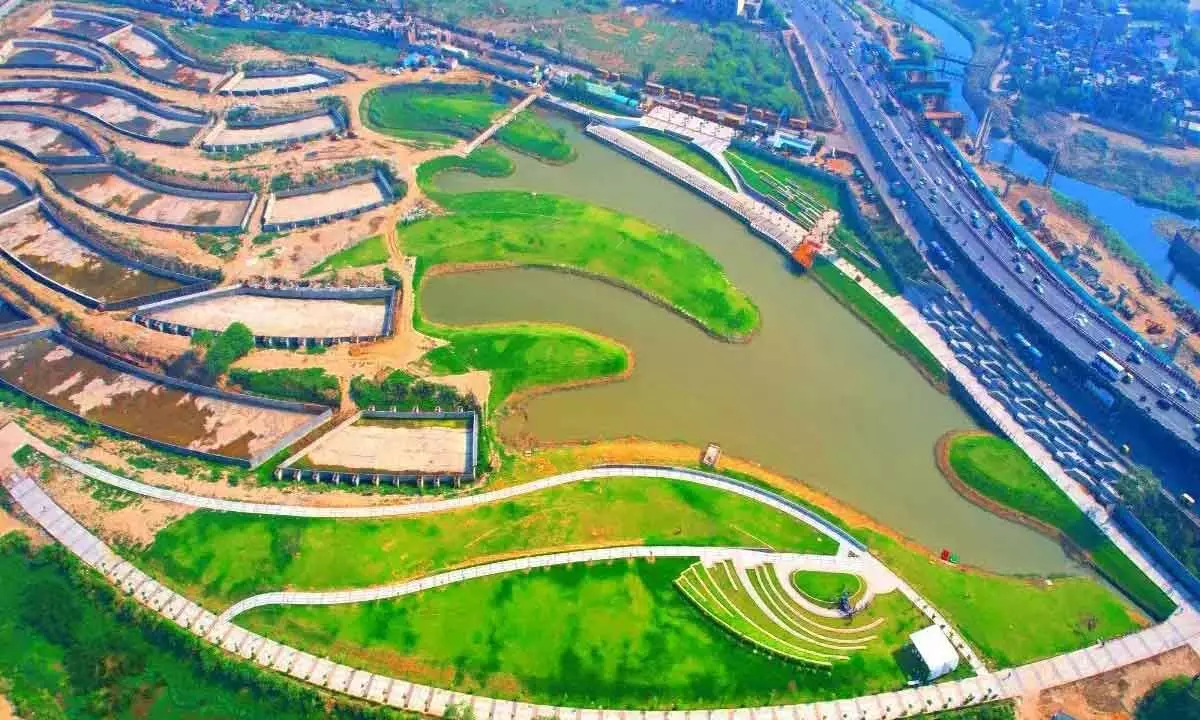From Infamous To Inviting: Timarpur Lake In Delhi Undergoes Transformation

- Timarpur Lake in northern Delhi sheds its history of criminal associations and sewage odor as it readies to unveil new amenities like an amphitheater, children's play area, and ornamental fountains.
- This marks the start of Delhi's plan to strengthen water reserves and reduce dependence on neighboring states through the 'City of Lakes' initiative.
For years, Timarpur Lake situated in northern Delhi has been infamous for its association with minor criminal activities and the unpleasant stench of sewage. However, a transformation is underway as the lake prepares to welcome visitors with new features like an amphitheater, a children's play area, and decorative fountains that adorn the landscape.
This renovation marks one of the initial steps in Delhi's extensive plan to fortify its water reserves and decrease its reliance on neighboring states. Through the 'City of Lakes' initiative, the Delhi government aims to develop around 600 water bodies functioning as natural reservoirs to store surplus rainwater and recycled water. In the past, Delhi, encompassing New Delhi, boasted over 1,000 water bodies, yet rapid urbanization has transformed it into a city notorious for polluted air and perilous roads.
The loss of freshwater ponds and lakes has left Delhi grappling with a water deficit of 1135 million liters per day, nearly a quarter of the city's demand – equivalent to more than 450 Olympic-sized swimming pools. Nevertheless, rejuvenating these lakes is no straightforward task. Many require adjoining water treatment facilities, and despite budget constraints, pandemic challenges, and bureaucratic hurdles across governmental departments, the project has taken five years to kick off. As of now, fewer than 50 lakes have been successfully restored.
According to Madhu Verma, Chief Economist at WRI India, an organization specializing in sustainable solutions, some of these water bodies are in dire condition and will necessitate significant investment. Nonetheless, there's a need to educate investors and planners about the advantages and cost-effectiveness of such infrastructure.
Delhi's water dilemma – both excess and scarcity – became apparent during the recent monsoon season. The city experienced the worst flooding in decades, causing damage and leading to the temporary shutdown of three water treatment facilities due to floodwater infiltration.
On a national scale, India confronts a pressing need for clean water to cater to its swiftly growing population. While being home to 16% of the world's population, it possesses only 4% of the planet's freshwater resources. Completed projects have displayed some success, with reported groundwater level increases of up to six meters, as per the Delhi government. Nonetheless, restoring the lakes, and sometimes crafting artificial ones, poses challenges.
The City of Lakes project aims to utilize the approximately 1900 million liters of recycled water produced daily in Delhi, much of which currently goes to waste. This water will be channeled into the lakes and subjected to further treatment in reverse osmosis plants before being distributed to households.
While another objective of the project is flood mitigation, experts express skepticism. The recent floods were primarily attributed to urbanization in low-lying regions lacking proper drainage systems. Manu Bhatnagar, who leads the Natural Heritage Division at the Indian National Trust for Art and Cultural Heritage (INTACH), voiced reservations about the lakes acting as flood buffers due to their small size and unfavorable locations.
Numerous lakes shrank or were utilized as dumping grounds due to encroachments for construction in pursuit of economic growth. Despite this, the restorations are anticipated to enhance the quality of life for Delhi's residents, and attract avian and plant life that contribute positively to lake ecosystems.
At Timarpur Lake, a labor force of approximately 50 workers is diligently wrapping up work on the sewage treatment plant that will supply recycled water to the lake. The large iron gate bearing the Hindi inscription "Work in Progress. Accident Prone Area" is set to open to the public this year.

















